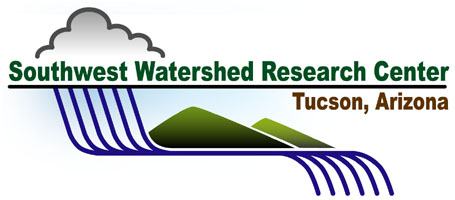| SWRC Bulletin (Spring 2005) |

|
  |  | The SWRC QuarterlySound Science for Watershed Decisions Spring 2005 |
| Latest Science Results (not yet published) (click on title for more information) Using airborne lidar to discern age classes of cottonwood trees
A graphical tool for water quality conservation planning
Planning agricultural research looking ahead from 2005
Slope shape effects on erosion: A laboratory study
Modeling response of soil erosion and runoff to changes in precipitation and cover
Potential effects of climate change on rainfall erosivity in the yellow river basin of China
Vegetation-hydrology interactions: Dynamics of riparian plant water use along the Canopy temperatures variability as an indicator of crop water stress severity
Application of the
Partitioning of evapotranspiration and its relation to carbon dioxide exchange in a Measuring sediment yield rates from semiarid rangeland watershed | Papers Published This Quarter: (click on title to download a reprint) Gomez, J.A., Nearing, M.A. 2005. Runoff and sediment losses from rough and smooth soil surfaces in a laboratory experiment. Catena 59:253-266. Huxman, T.E., Wilcox, B.P., Scott, R.L., Snyder, K.A., Small, E.E., Hultine, K.R., Pockman, W.T., McLain, J.E.T., Martens, D.A. 2005. Nitrous oxide flux from soil amino acid mineralization. Soil Biology and Biochemistry 37:289-299. Rieke-Zapp, D.H., Nearing, M.A., 2005. Digital close range photogrammetry for measurement of soil erosion. The Photogrammetric Record 20:69-87. Our full publication list is available at http://www.tucson.ars.ag.gov/unit/Publications/search.html .
Future Science Events: Workshops on sedimentation, evaporation, remote sensing and soil moisture are planned. See the latest research plans for a rangeland hydrology and erosion model (RHEM) and a new long-term eddy covariance site at Walnut Gulch Experimental Watershed. (click here for more information) Rainfall Report:
WGEW and SRER data can be downloaded from the web site at http://www.tucson.ars.ag.gov/dap Awards: SWRC scientists won a host of awards at the recent meeting of the American Society of Civil Engineers. Congratulations to Ken Renard for the ASCE Lifetime Achievement Award. (click here for more information) Staff News: This issue of our SWRC Quarterly is in memory of the hard work and gentle nature of SWRC Scientist Terri Kelly. (click here for more information) SWRC Quarterly: Contact the SWRC Research Leader, Dr. Susan Moran at 670-6380 X171 or smoran@tucson.ars.ag.gov. Mailing address is USDA ARS SWRC, SWRC The Southwest Watershed Research Center conducts long-term research of soil, water and climate processes to better understand interactions with plants, animals and humans as a basis for management of semiarid watersheds. SWRC develops new technologies for land managers, including remote sensing, computer-aided decision tools, and ecosystem models. |



